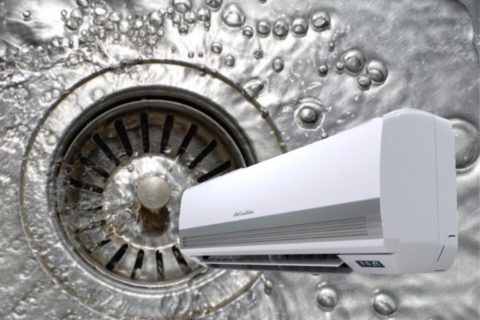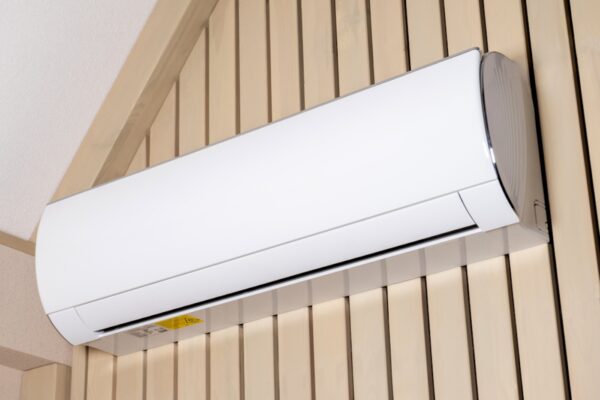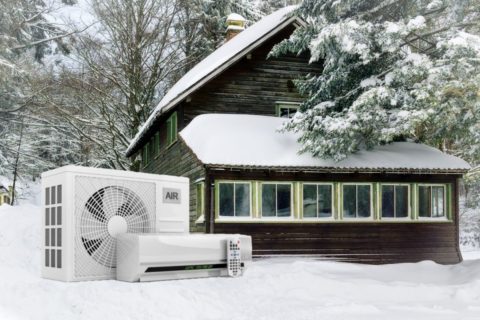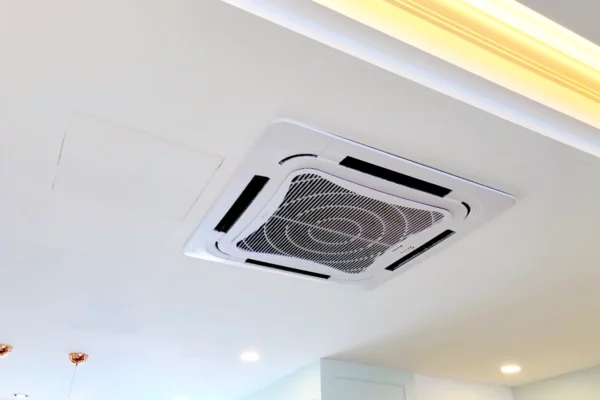Mini Split in Attic: Is It a Good Idea?
If you’re converting an attic into a living space, you might be wondering if a mini split is right for you. In this blog post, I’ll explain the pros and cons of installing a mini split in an attic along with my recommendations.
Generally, mini splits are good for attic heating and cooling. Instead of upgrading your existing HVAC system, you can save money by installing a mini split in your attic. When compared to other room air conditioners, mini splits are much more efficient and quieter.
Some people shy away from mini splits due to lack of understanding. As a result, they miss out on a great opportunity to save money and reduce energy costs
Why Mini Splits are Good for Attics?
When you convert an attic into a living space, you increase the square footage that needs heating and cooling. If your existing HVAC system can’t accommodate the increase, you’ll need to upgrade it.
Upgrading an existing HVAC system is no joke.
Depending on your current system, you may need a new set of equipment with a bigger capacity. Even if your existing system has enough capacity, you still need to pay for the additional ductwork to the attic.
So, I recommend you consider a separate system, a room air conditioner.
Among room air conditioners, I find that a mini split is currently the best option and here is why:
- Federal Tax Credit
Energy Star provides up to $2000 tax credits for homeowners who purchase and install a mini split system between 1st January 2023 and 31st December 2032. - Energy Efficiency
A basic mini split is about twice as efficient as a window air conditioner and portable air conditioner, not to mention a high-efficient model. - Cooling and Heating
Almost all mini splits can heat and cool. Window and portable air conditioners mostly provide cooling only with a few exceptions. Hence, you solve two issues with one system. - Noise Level
Mini splits are extremely quiet. In a small space like an attic, a noisy air conditioner like a portable air conditioner is unbearable. - Installation Flexibility
Mini splits come in different forms. You can mount it up high on the wall to save space, hang it in the center for uniform air distribution or mount it on the floor if you have a low-ceiling attic.
Overall, mini splits are very appealing. Plus, the government is incentivizing you for installing one. Nonetheless, let’s compare mini splits with other room air conditioners so that you can make a more informed decision.
Mini Split Comparison: Attic Application
I’ve dealt with many residential air conditioners. When it comes to a dedicated heating and cooling system for small rooms like attics, there are three options to choose from, namely:
- Mini Split
- Window AC
- Portable AC
Each option has its pros and cons. Depending on what you’re converting the attic into, a mini split might not be your first choice.
By the way, if you want to learn more about mini split especially how to design it for your house, consider my Mini Split (eBook). You’ll learn what is Mini Split, how to choose and more importantly, spark more design ideas to improve the energy efficient of your house. But, if you need a second opinion or want someone to help you design, then you can consider my consultation service.
Consultation Service
Ask me for HVAC advice such as brand selection, best model, benefits, features, placement, duct size, grille size, how to design, design check, verification and other HVAC related queries.
Mini Split
Mini splits are more efficient and quieter than window ACs and portable ACs. Wall-mounted and ceiling cassette mini splits are installed up high on the wall and thus, save space. However, mini splits are more expensive than the two and required more work on installation and maintenance.
Pros
- High energy efficiency
- Very quiet operation
- Space saving
Cons
- Expensive
- Complex installation
- More maintenance
If you’re converting the attic into a bedroom, a study room or a media room, a mini split is perhaps the best choice due to its quiet operation. Whether you’re renting out or planning to let your children sleep in the attic, a mini split ensures the space is comfortable and undisturbed.
Window AC
Window ACs are more affordable than mini splits and portable ACs. They are also easy to install and maintain. However, window ACs are noisier and less efficient than mini splits, and they required a window for the installation.
Pros
- Affordable
- Easy to install
- Easy to maintain
Cons
- Noisy
- Less efficient
- Required a window
If you’re converting the attic into a store or a gym, noise is not a big deal and thus, a window AC is great because it is the most affordable option. However, your attic needs to have a window or else, you have no place to put the window AC.
Portable AC
Portable ACs and cheaper than mini splits but more expensive than window ACs. Their benefits are portable and simple. However, portable ACs are known for their poor efficiency and noisy operation. Plus, they need an exhaust hose which can be inconvenient.
Pros
- Cheaper than mini split
- Portable
- Simple
Cons
- Poor energy efficiency
- Noisy
- Need an exhaust hose
If you’re converting the attic into a space that doesn’t affect by a noisy air conditioner, a portable air conditioner is good enough. When not needed, you can simply move it to other rooms. However, portable ACs need a small hole in the attic wall for the exhaust hose.
Where to Put a Mini Split Air Handler in Attic?
After you are finally convinced to use a mini split for your attic, here comes the question: where do you put the air handler? Some people back away from a mini split because they can’t find a suitable location to put the air handler. So, here are a few installation ideas:

Ductless Mini Split in Attic
A ductless wall-mounted mini split can be installed on the gable wall in an attic. It is fine to put it above the window but do leave a few inches gap above the unit for return air. If your attic is longer than 20 ft, I recommend you install one on each end to avoid creating hot spots in the attic.
Ceiling Cassette Mini Split in Attic
A ceiling cassette mini split can be installed at the center of the attic. A ceiling is not necessary with regard to the functionality of the ceiling cassette unit.
Additionally, you can duct the ceiling cassette unit to the outside and draw fresh air into the attic space which greatly improves the attic environment.
Ceiling cassette mini splits are slightly more complicated than wall-mounted mini splits. To learn more about them, see my post: How Ceiling Cassette Mini Splits Work.

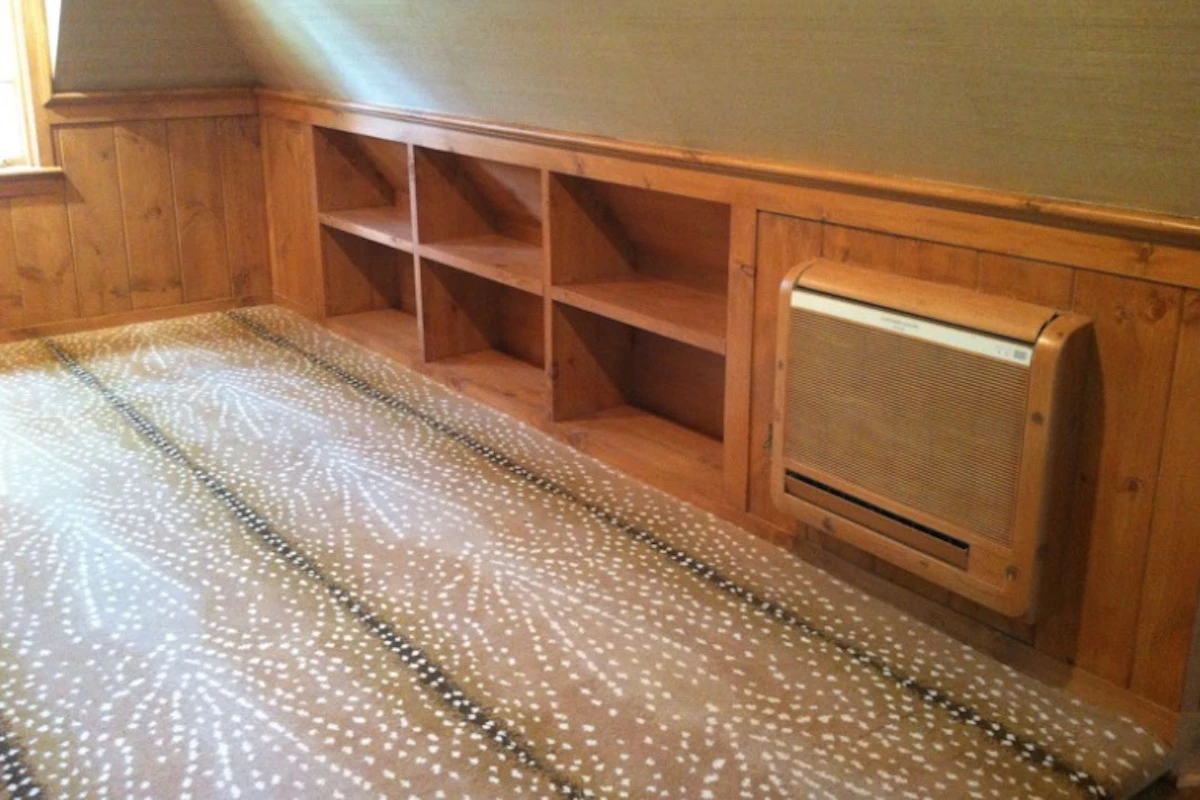
Floor-Mounted Mini Split in Attic
A floor-mounted mini split can be installed in an attic that has a knee wall. It is a good option, especially when you don’t have space to mount the wall unit.
Mini Split Performance in Attic
The attic is naturally a warm space as hot air rises to the top of your house. So, using one size bigger mini split usually doesn’t hurt. However, be careful not to oversize it as some attics are really small.
Most importantly, your attic must be insulated or else, not much heating or cooling can be done.
If you plan to install a ceiling in your attic, the ceiling cassette type of mini splits will have its body exposed to a hot environment as it sits right under the roof. In such a case, you need to be aware of the following items:
- If your attic is completely uninsulated, condensation may occur on the surface of the ceiling cassette unit that is protruding above the attic ceiling due to the immense heat. Insulate the attic or the ceiling cassette unit to stop the condensation.
- If your attic is insulated with fiberglass or mineral wool, isolate the ceiling cassette to prevent the insulation material from entering the ceiling cassette unit which can lead to all sorts of problems including an electrical-induced fire.
- Provide a decently-sized ceiling manhole right beside the ceiling cassette unit for service access according the to installation manual. The ceiling manhole should allow access to the piping connection. Cleaning work can be done without accessing the space above the ceiling.
Now that you have more knowledge about having a mini split in the attic. Following are my recommended mini splits for attics for your reference.
My Recommended Mini Splits for Attics
Since there is a federal tax credit, it is best to buy a mini split that is eligible for the incentive. So, I’ve shortlisted a few Energy Star certified mini splits that I think are good as follows:
- Senville AURA (SENA) Series | View Certification | Check Price on Amazon
- MrCool DIY (4th Gen) Series | View Certification | Check Price on Amazon
- Gree Vireo+ (Gen 3) Series | View Certification | Check Price on Amazon
Lastly, consider my Mini Split (eBook) if you want to know how can you use Mini Split in your house. If you still have doubt or not feeling confident enough, feel free to consult me.
Consultation Service
Ask me for HVAC advice such as brand selection, best model, benefits, features, placement, duct size, grille size, how to design, design check, verification and other HVAC related queries.
If you have anything to add (or ask) about this topic, leave a comment down below!


